Report on Scientific Management and Human Relationship Theories
VerifiedAdded on 2020/05/08
|7
|1908
|109
Report
AI Summary
This report delves into the evolution of management thought by examining two pivotal theories: scientific management, pioneered by Frederick Winslow Taylor, and human relations management, largely influenced by Elton Mayo. Scientific management emphasizes efficiency through task standardization and worker specialization, aiming to maximize productivity. In contrast, human relations theory highlights the significance of employee motivation, interpersonal relationships, and workplace environment in driving productivity. The report contrasts these approaches, illustrating their differences in employee treatment, motivational strategies, and workplace dynamics. It also underscores the similarities, particularly their shared goal of enhancing organizational performance. The analysis concludes by highlighting the enduring contributions of both theories to contemporary management practices, emphasizing their role in shaping modern organizational structures and leadership styles.
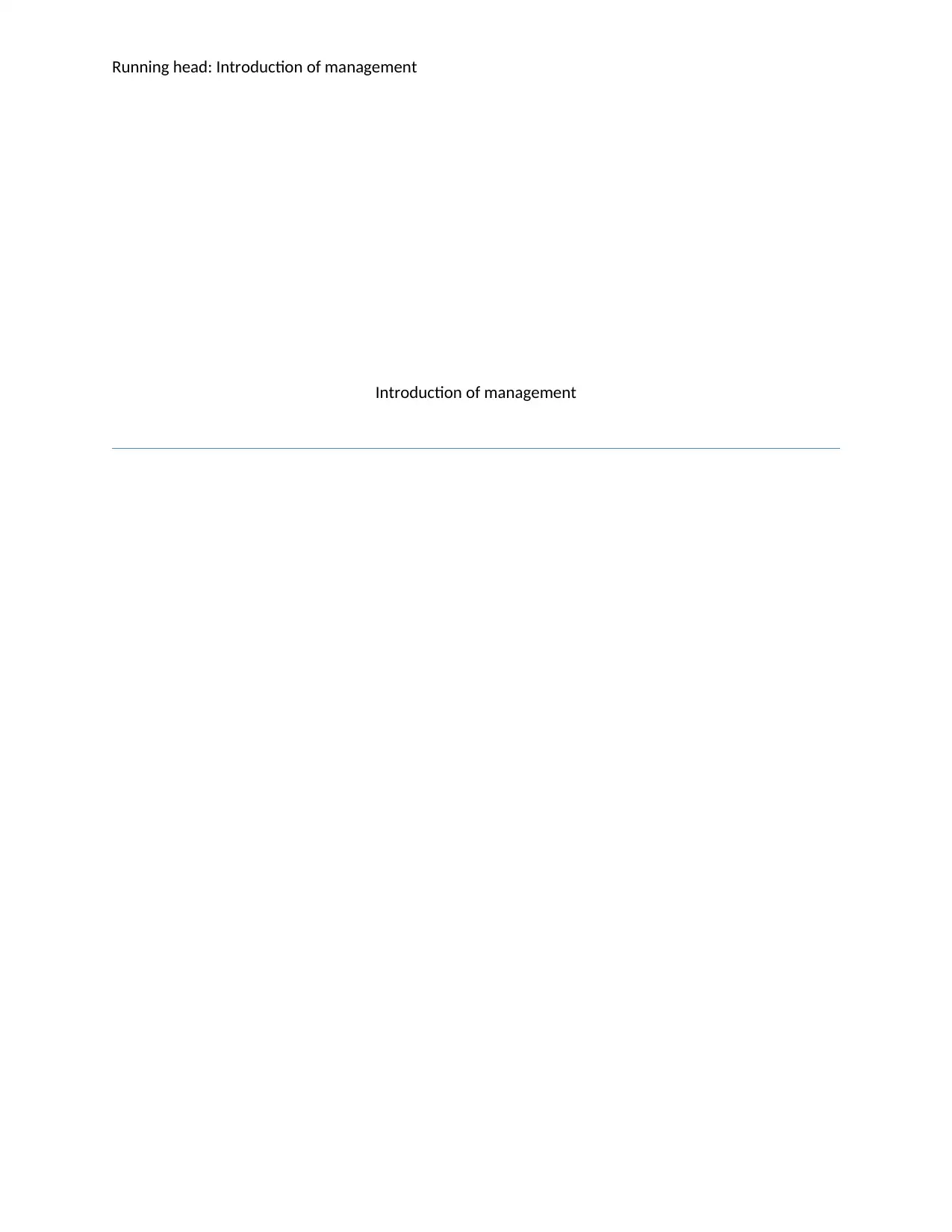
Running head: Introduction of management
Introduction of management
Introduction of management
Paraphrase This Document
Need a fresh take? Get an instant paraphrase of this document with our AI Paraphraser
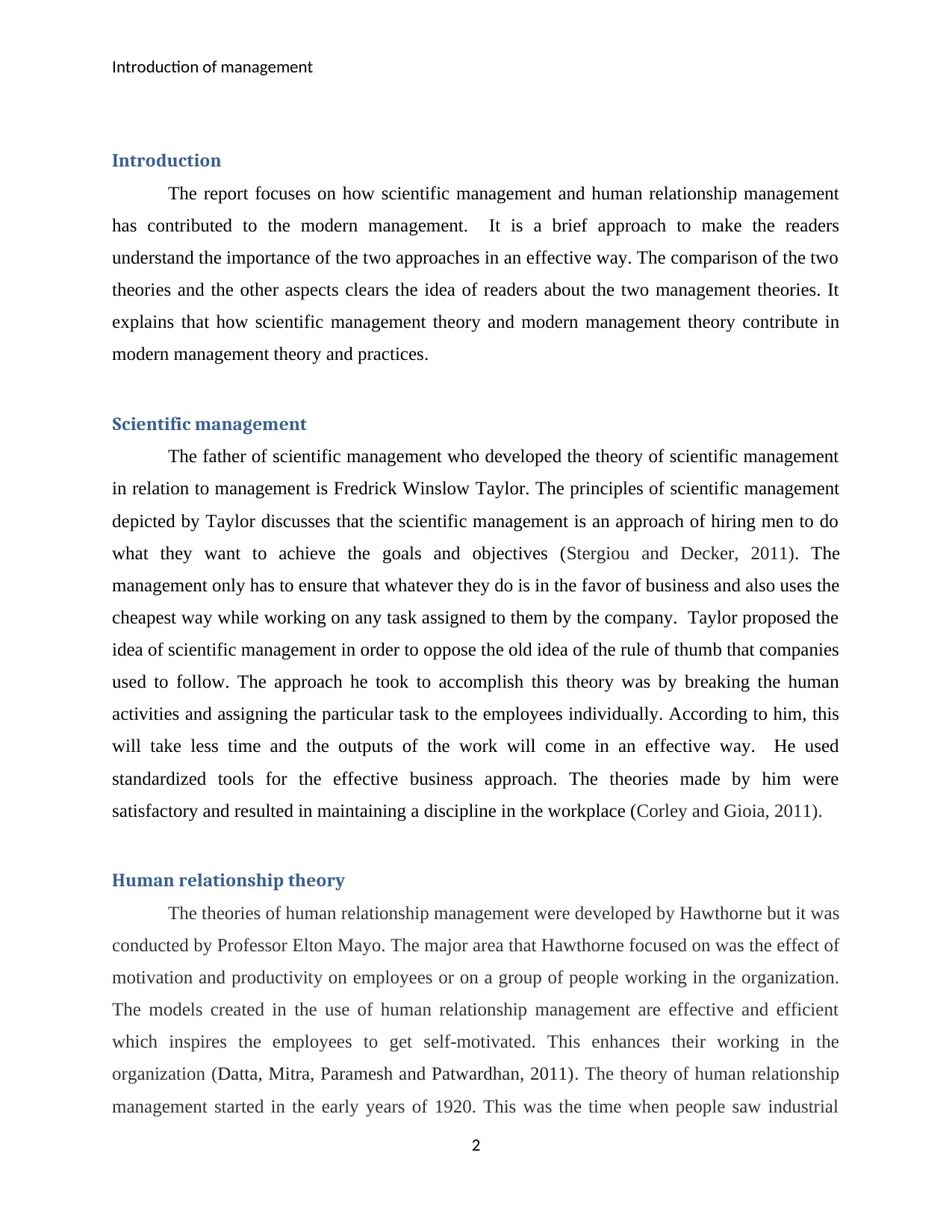
Introduction of management
Introduction
The report focuses on how scientific management and human relationship management
has contributed to the modern management. It is a brief approach to make the readers
understand the importance of the two approaches in an effective way. The comparison of the two
theories and the other aspects clears the idea of readers about the two management theories. It
explains that how scientific management theory and modern management theory contribute in
modern management theory and practices.
Scientific management
The father of scientific management who developed the theory of scientific management
in relation to management is Fredrick Winslow Taylor. The principles of scientific management
depicted by Taylor discusses that the scientific management is an approach of hiring men to do
what they want to achieve the goals and objectives (Stergiou and Decker, 2011). The
management only has to ensure that whatever they do is in the favor of business and also uses the
cheapest way while working on any task assigned to them by the company. Taylor proposed the
idea of scientific management in order to oppose the old idea of the rule of thumb that companies
used to follow. The approach he took to accomplish this theory was by breaking the human
activities and assigning the particular task to the employees individually. According to him, this
will take less time and the outputs of the work will come in an effective way. He used
standardized tools for the effective business approach. The theories made by him were
satisfactory and resulted in maintaining a discipline in the workplace (Corley and Gioia, 2011).
Human relationship theory
The theories of human relationship management were developed by Hawthorne but it was
conducted by Professor Elton Mayo. The major area that Hawthorne focused on was the effect of
motivation and productivity on employees or on a group of people working in the organization.
The models created in the use of human relationship management are effective and efficient
which inspires the employees to get self-motivated. This enhances their working in the
organization (Datta, Mitra, Paramesh and Patwardhan, 2011). The theory of human relationship
management started in the early years of 1920. This was the time when people saw industrial
2
Introduction
The report focuses on how scientific management and human relationship management
has contributed to the modern management. It is a brief approach to make the readers
understand the importance of the two approaches in an effective way. The comparison of the two
theories and the other aspects clears the idea of readers about the two management theories. It
explains that how scientific management theory and modern management theory contribute in
modern management theory and practices.
Scientific management
The father of scientific management who developed the theory of scientific management
in relation to management is Fredrick Winslow Taylor. The principles of scientific management
depicted by Taylor discusses that the scientific management is an approach of hiring men to do
what they want to achieve the goals and objectives (Stergiou and Decker, 2011). The
management only has to ensure that whatever they do is in the favor of business and also uses the
cheapest way while working on any task assigned to them by the company. Taylor proposed the
idea of scientific management in order to oppose the old idea of the rule of thumb that companies
used to follow. The approach he took to accomplish this theory was by breaking the human
activities and assigning the particular task to the employees individually. According to him, this
will take less time and the outputs of the work will come in an effective way. He used
standardized tools for the effective business approach. The theories made by him were
satisfactory and resulted in maintaining a discipline in the workplace (Corley and Gioia, 2011).
Human relationship theory
The theories of human relationship management were developed by Hawthorne but it was
conducted by Professor Elton Mayo. The major area that Hawthorne focused on was the effect of
motivation and productivity on employees or on a group of people working in the organization.
The models created in the use of human relationship management are effective and efficient
which inspires the employees to get self-motivated. This enhances their working in the
organization (Datta, Mitra, Paramesh and Patwardhan, 2011). The theory of human relationship
management started in the early years of 1920. This was the time when people saw industrial
2
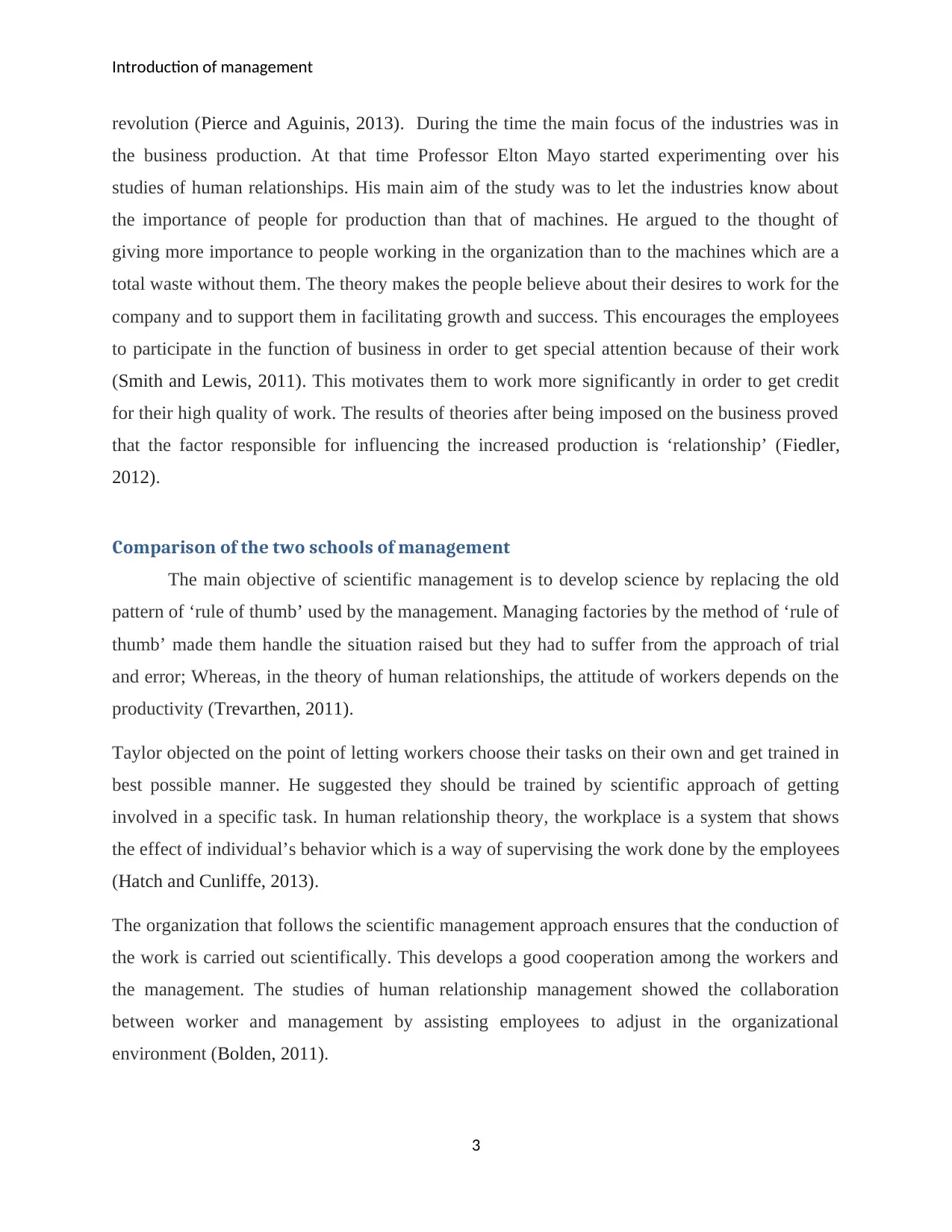
Introduction of management
revolution (Pierce and Aguinis, 2013). During the time the main focus of the industries was in
the business production. At that time Professor Elton Mayo started experimenting over his
studies of human relationships. His main aim of the study was to let the industries know about
the importance of people for production than that of machines. He argued to the thought of
giving more importance to people working in the organization than to the machines which are a
total waste without them. The theory makes the people believe about their desires to work for the
company and to support them in facilitating growth and success. This encourages the employees
to participate in the function of business in order to get special attention because of their work
(Smith and Lewis, 2011). This motivates them to work more significantly in order to get credit
for their high quality of work. The results of theories after being imposed on the business proved
that the factor responsible for influencing the increased production is ‘relationship’ (Fiedler,
2012).
Comparison of the two schools of management
The main objective of scientific management is to develop science by replacing the old
pattern of ‘rule of thumb’ used by the management. Managing factories by the method of ‘rule of
thumb’ made them handle the situation raised but they had to suffer from the approach of trial
and error; Whereas, in the theory of human relationships, the attitude of workers depends on the
productivity (Trevarthen, 2011).
Taylor objected on the point of letting workers choose their tasks on their own and get trained in
best possible manner. He suggested they should be trained by scientific approach of getting
involved in a specific task. In human relationship theory, the workplace is a system that shows
the effect of individual’s behavior which is a way of supervising the work done by the employees
(Hatch and Cunliffe, 2013).
The organization that follows the scientific management approach ensures that the conduction of
the work is carried out scientifically. This develops a good cooperation among the workers and
the management. The studies of human relationship management showed the collaboration
between worker and management by assisting employees to adjust in the organizational
environment (Bolden, 2011).
3
revolution (Pierce and Aguinis, 2013). During the time the main focus of the industries was in
the business production. At that time Professor Elton Mayo started experimenting over his
studies of human relationships. His main aim of the study was to let the industries know about
the importance of people for production than that of machines. He argued to the thought of
giving more importance to people working in the organization than to the machines which are a
total waste without them. The theory makes the people believe about their desires to work for the
company and to support them in facilitating growth and success. This encourages the employees
to participate in the function of business in order to get special attention because of their work
(Smith and Lewis, 2011). This motivates them to work more significantly in order to get credit
for their high quality of work. The results of theories after being imposed on the business proved
that the factor responsible for influencing the increased production is ‘relationship’ (Fiedler,
2012).
Comparison of the two schools of management
The main objective of scientific management is to develop science by replacing the old
pattern of ‘rule of thumb’ used by the management. Managing factories by the method of ‘rule of
thumb’ made them handle the situation raised but they had to suffer from the approach of trial
and error; Whereas, in the theory of human relationships, the attitude of workers depends on the
productivity (Trevarthen, 2011).
Taylor objected on the point of letting workers choose their tasks on their own and get trained in
best possible manner. He suggested they should be trained by scientific approach of getting
involved in a specific task. In human relationship theory, the workplace is a system that shows
the effect of individual’s behavior which is a way of supervising the work done by the employees
(Hatch and Cunliffe, 2013).
The organization that follows the scientific management approach ensures that the conduction of
the work is carried out scientifically. This develops a good cooperation among the workers and
the management. The studies of human relationship management showed the collaboration
between worker and management by assisting employees to adjust in the organizational
environment (Bolden, 2011).
3
⊘ This is a preview!⊘
Do you want full access?
Subscribe today to unlock all pages.

Trusted by 1+ million students worldwide
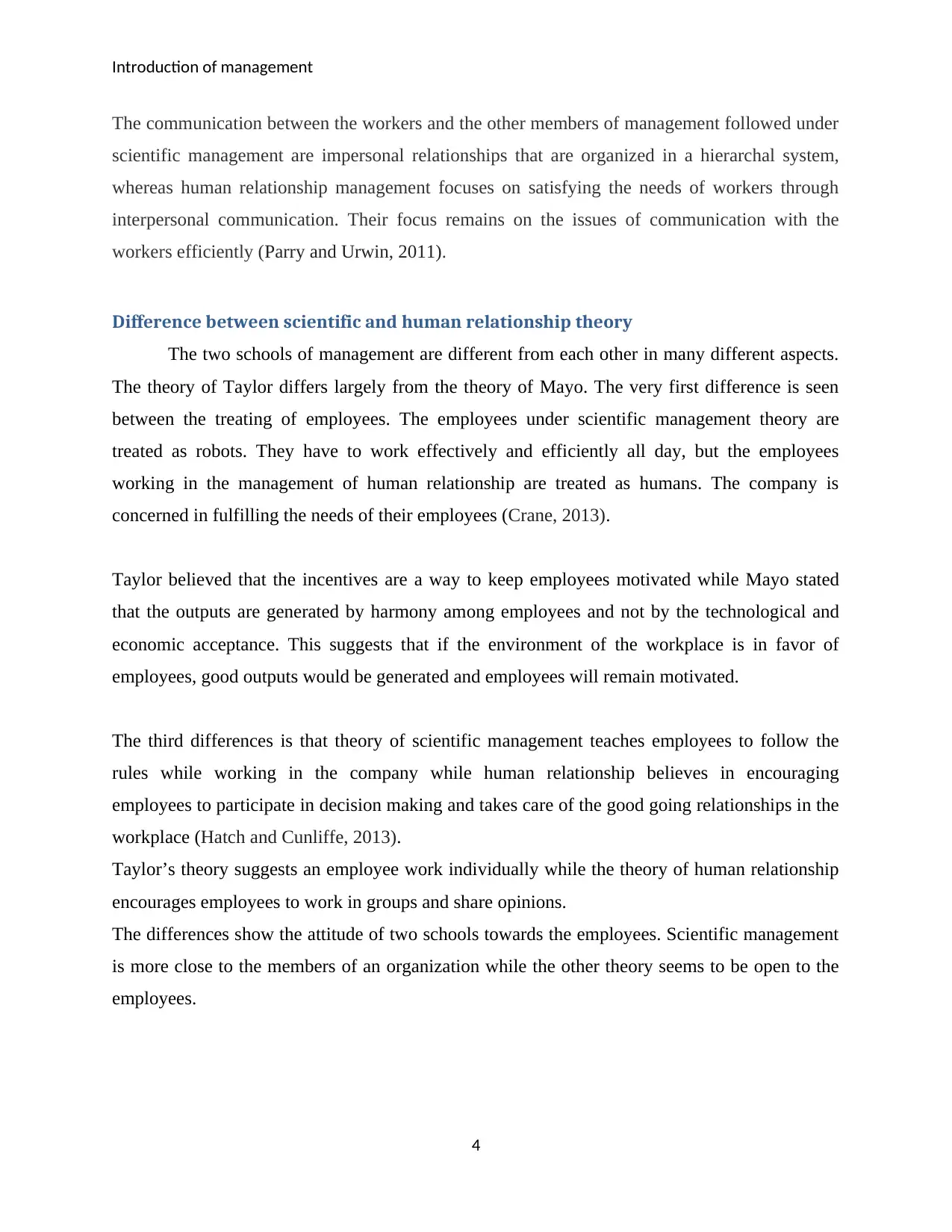
Introduction of management
The communication between the workers and the other members of management followed under
scientific management are impersonal relationships that are organized in a hierarchal system,
whereas human relationship management focuses on satisfying the needs of workers through
interpersonal communication. Their focus remains on the issues of communication with the
workers efficiently (Parry and Urwin, 2011).
Difference between scientific and human relationship theory
The two schools of management are different from each other in many different aspects.
The theory of Taylor differs largely from the theory of Mayo. The very first difference is seen
between the treating of employees. The employees under scientific management theory are
treated as robots. They have to work effectively and efficiently all day, but the employees
working in the management of human relationship are treated as humans. The company is
concerned in fulfilling the needs of their employees (Crane, 2013).
Taylor believed that the incentives are a way to keep employees motivated while Mayo stated
that the outputs are generated by harmony among employees and not by the technological and
economic acceptance. This suggests that if the environment of the workplace is in favor of
employees, good outputs would be generated and employees will remain motivated.
The third differences is that theory of scientific management teaches employees to follow the
rules while working in the company while human relationship believes in encouraging
employees to participate in decision making and takes care of the good going relationships in the
workplace (Hatch and Cunliffe, 2013).
Taylor’s theory suggests an employee work individually while the theory of human relationship
encourages employees to work in groups and share opinions.
The differences show the attitude of two schools towards the employees. Scientific management
is more close to the members of an organization while the other theory seems to be open to the
employees.
4
The communication between the workers and the other members of management followed under
scientific management are impersonal relationships that are organized in a hierarchal system,
whereas human relationship management focuses on satisfying the needs of workers through
interpersonal communication. Their focus remains on the issues of communication with the
workers efficiently (Parry and Urwin, 2011).
Difference between scientific and human relationship theory
The two schools of management are different from each other in many different aspects.
The theory of Taylor differs largely from the theory of Mayo. The very first difference is seen
between the treating of employees. The employees under scientific management theory are
treated as robots. They have to work effectively and efficiently all day, but the employees
working in the management of human relationship are treated as humans. The company is
concerned in fulfilling the needs of their employees (Crane, 2013).
Taylor believed that the incentives are a way to keep employees motivated while Mayo stated
that the outputs are generated by harmony among employees and not by the technological and
economic acceptance. This suggests that if the environment of the workplace is in favor of
employees, good outputs would be generated and employees will remain motivated.
The third differences is that theory of scientific management teaches employees to follow the
rules while working in the company while human relationship believes in encouraging
employees to participate in decision making and takes care of the good going relationships in the
workplace (Hatch and Cunliffe, 2013).
Taylor’s theory suggests an employee work individually while the theory of human relationship
encourages employees to work in groups and share opinions.
The differences show the attitude of two schools towards the employees. Scientific management
is more close to the members of an organization while the other theory seems to be open to the
employees.
4
Paraphrase This Document
Need a fresh take? Get an instant paraphrase of this document with our AI Paraphraser
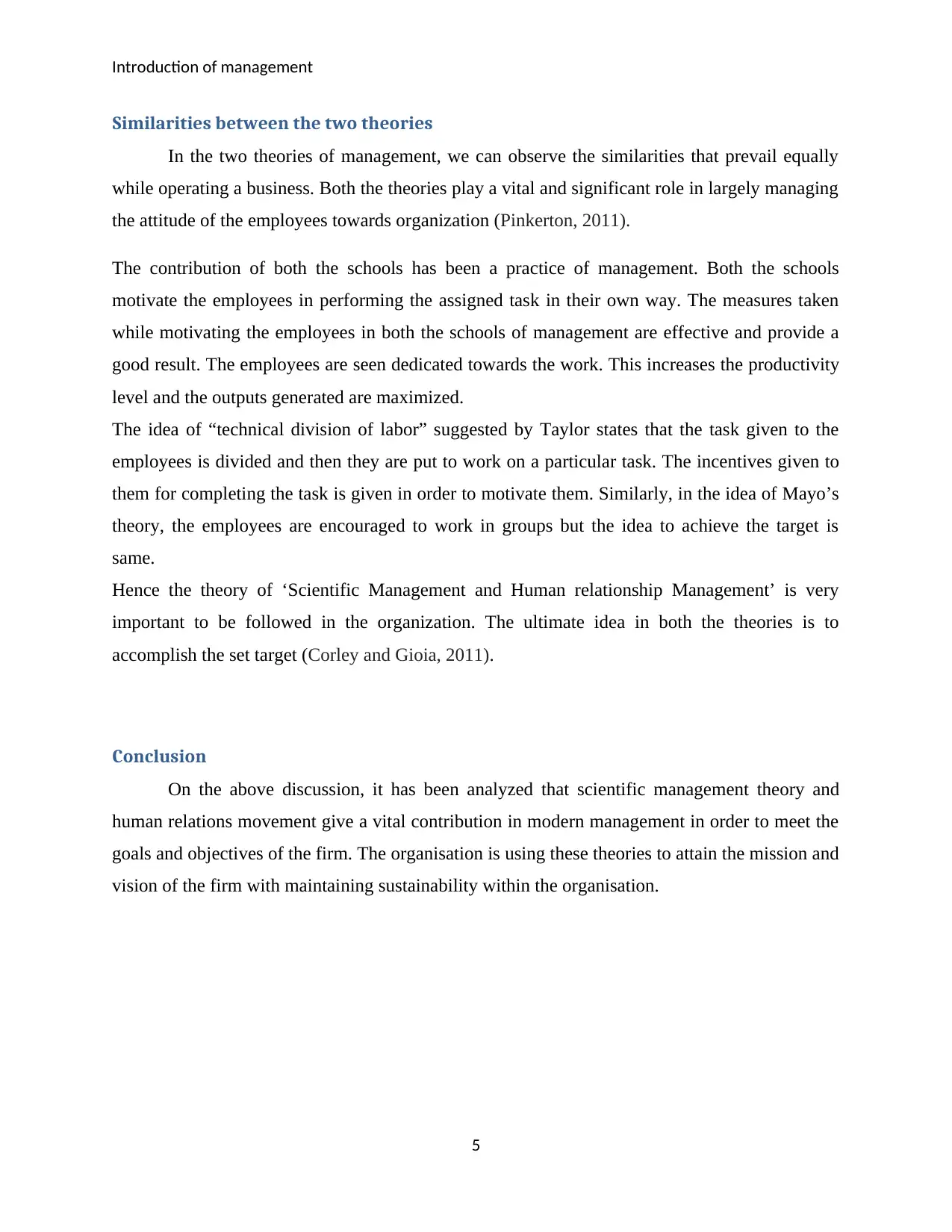
Introduction of management
Similarities between the two theories
In the two theories of management, we can observe the similarities that prevail equally
while operating a business. Both the theories play a vital and significant role in largely managing
the attitude of the employees towards organization (Pinkerton, 2011).
The contribution of both the schools has been a practice of management. Both the schools
motivate the employees in performing the assigned task in their own way. The measures taken
while motivating the employees in both the schools of management are effective and provide a
good result. The employees are seen dedicated towards the work. This increases the productivity
level and the outputs generated are maximized.
The idea of “technical division of labor” suggested by Taylor states that the task given to the
employees is divided and then they are put to work on a particular task. The incentives given to
them for completing the task is given in order to motivate them. Similarly, in the idea of Mayo’s
theory, the employees are encouraged to work in groups but the idea to achieve the target is
same.
Hence the theory of ‘Scientific Management and Human relationship Management’ is very
important to be followed in the organization. The ultimate idea in both the theories is to
accomplish the set target (Corley and Gioia, 2011).
Conclusion
On the above discussion, it has been analyzed that scientific management theory and
human relations movement give a vital contribution in modern management in order to meet the
goals and objectives of the firm. The organisation is using these theories to attain the mission and
vision of the firm with maintaining sustainability within the organisation.
5
Similarities between the two theories
In the two theories of management, we can observe the similarities that prevail equally
while operating a business. Both the theories play a vital and significant role in largely managing
the attitude of the employees towards organization (Pinkerton, 2011).
The contribution of both the schools has been a practice of management. Both the schools
motivate the employees in performing the assigned task in their own way. The measures taken
while motivating the employees in both the schools of management are effective and provide a
good result. The employees are seen dedicated towards the work. This increases the productivity
level and the outputs generated are maximized.
The idea of “technical division of labor” suggested by Taylor states that the task given to the
employees is divided and then they are put to work on a particular task. The incentives given to
them for completing the task is given in order to motivate them. Similarly, in the idea of Mayo’s
theory, the employees are encouraged to work in groups but the idea to achieve the target is
same.
Hence the theory of ‘Scientific Management and Human relationship Management’ is very
important to be followed in the organization. The ultimate idea in both the theories is to
accomplish the set target (Corley and Gioia, 2011).
Conclusion
On the above discussion, it has been analyzed that scientific management theory and
human relations movement give a vital contribution in modern management in order to meet the
goals and objectives of the firm. The organisation is using these theories to attain the mission and
vision of the firm with maintaining sustainability within the organisation.
5
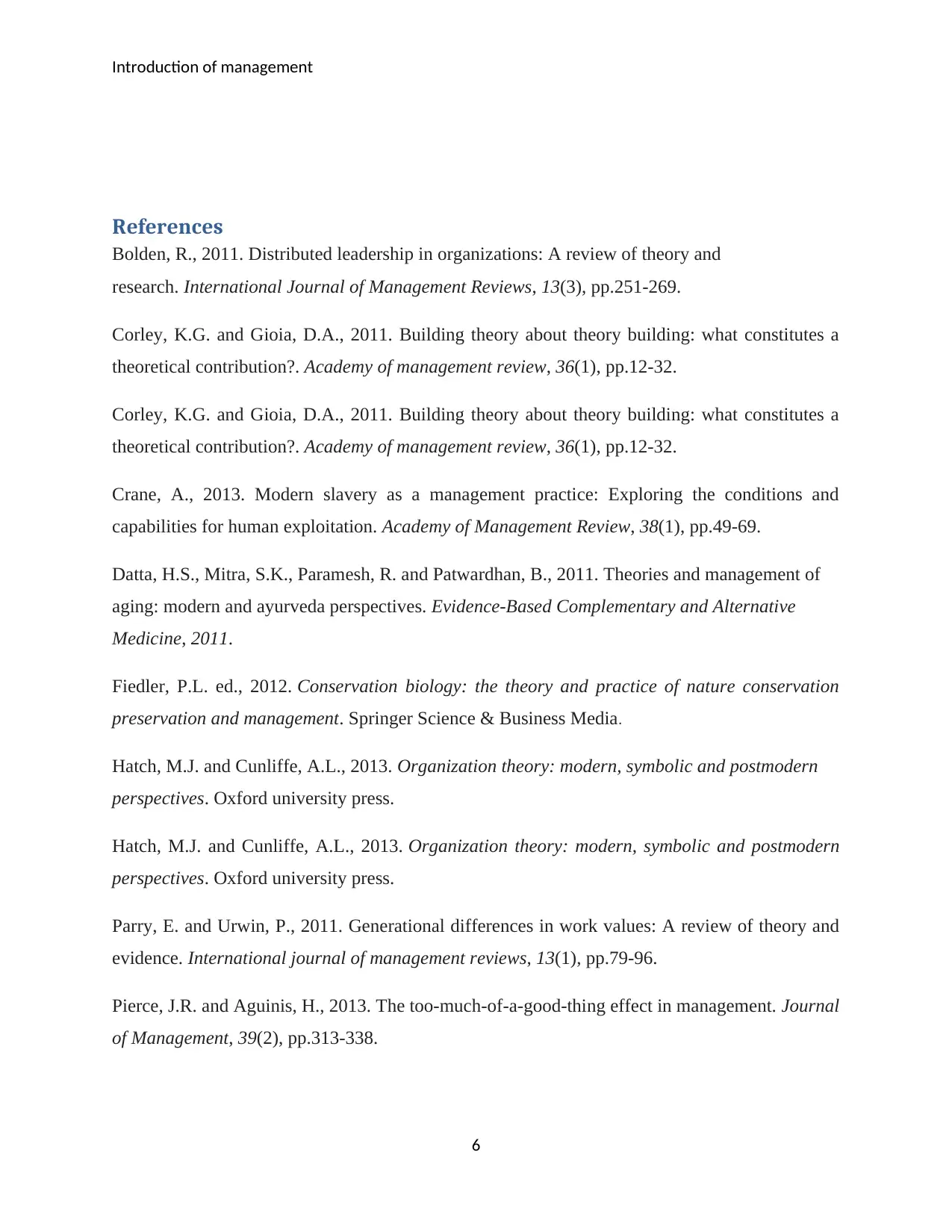
Introduction of management
References
Bolden, R., 2011. Distributed leadership in organizations: A review of theory and
research. International Journal of Management Reviews, 13(3), pp.251-269.
Corley, K.G. and Gioia, D.A., 2011. Building theory about theory building: what constitutes a
theoretical contribution?. Academy of management review, 36(1), pp.12-32.
Corley, K.G. and Gioia, D.A., 2011. Building theory about theory building: what constitutes a
theoretical contribution?. Academy of management review, 36(1), pp.12-32.
Crane, A., 2013. Modern slavery as a management practice: Exploring the conditions and
capabilities for human exploitation. Academy of Management Review, 38(1), pp.49-69.
Datta, H.S., Mitra, S.K., Paramesh, R. and Patwardhan, B., 2011. Theories and management of
aging: modern and ayurveda perspectives. Evidence-Based Complementary and Alternative
Medicine, 2011.
Fiedler, P.L. ed., 2012. Conservation biology: the theory and practice of nature conservation
preservation and management. Springer Science & Business Media.
Hatch, M.J. and Cunliffe, A.L., 2013. Organization theory: modern, symbolic and postmodern
perspectives. Oxford university press.
Hatch, M.J. and Cunliffe, A.L., 2013. Organization theory: modern, symbolic and postmodern
perspectives. Oxford university press.
Parry, E. and Urwin, P., 2011. Generational differences in work values: A review of theory and
evidence. International journal of management reviews, 13(1), pp.79-96.
Pierce, J.R. and Aguinis, H., 2013. The too-much-of-a-good-thing effect in management. Journal
of Management, 39(2), pp.313-338.
6
References
Bolden, R., 2011. Distributed leadership in organizations: A review of theory and
research. International Journal of Management Reviews, 13(3), pp.251-269.
Corley, K.G. and Gioia, D.A., 2011. Building theory about theory building: what constitutes a
theoretical contribution?. Academy of management review, 36(1), pp.12-32.
Corley, K.G. and Gioia, D.A., 2011. Building theory about theory building: what constitutes a
theoretical contribution?. Academy of management review, 36(1), pp.12-32.
Crane, A., 2013. Modern slavery as a management practice: Exploring the conditions and
capabilities for human exploitation. Academy of Management Review, 38(1), pp.49-69.
Datta, H.S., Mitra, S.K., Paramesh, R. and Patwardhan, B., 2011. Theories and management of
aging: modern and ayurveda perspectives. Evidence-Based Complementary and Alternative
Medicine, 2011.
Fiedler, P.L. ed., 2012. Conservation biology: the theory and practice of nature conservation
preservation and management. Springer Science & Business Media.
Hatch, M.J. and Cunliffe, A.L., 2013. Organization theory: modern, symbolic and postmodern
perspectives. Oxford university press.
Hatch, M.J. and Cunliffe, A.L., 2013. Organization theory: modern, symbolic and postmodern
perspectives. Oxford university press.
Parry, E. and Urwin, P., 2011. Generational differences in work values: A review of theory and
evidence. International journal of management reviews, 13(1), pp.79-96.
Pierce, J.R. and Aguinis, H., 2013. The too-much-of-a-good-thing effect in management. Journal
of Management, 39(2), pp.313-338.
6
⊘ This is a preview!⊘
Do you want full access?
Subscribe today to unlock all pages.

Trusted by 1+ million students worldwide
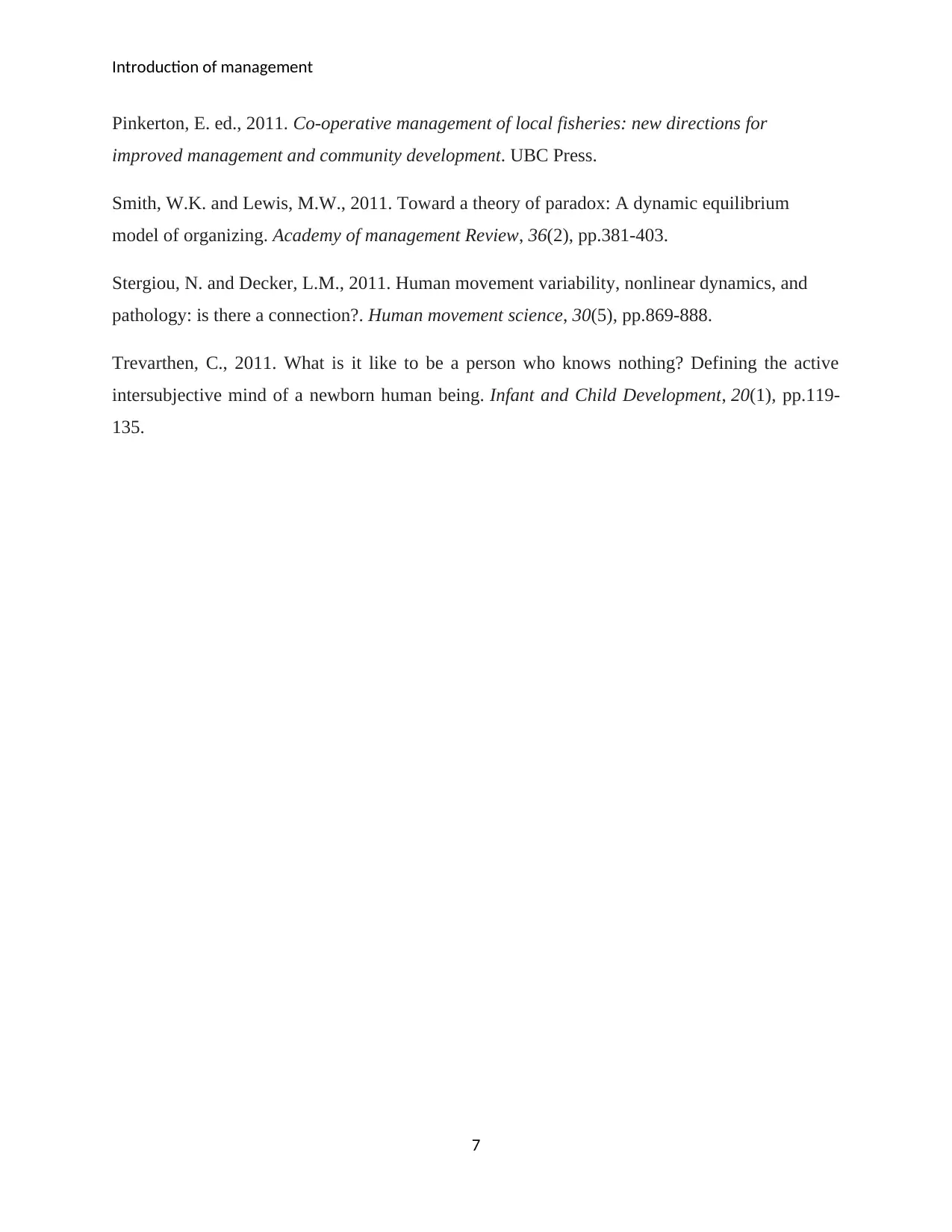
Introduction of management
Pinkerton, E. ed., 2011. Co-operative management of local fisheries: new directions for
improved management and community development. UBC Press.
Smith, W.K. and Lewis, M.W., 2011. Toward a theory of paradox: A dynamic equilibrium
model of organizing. Academy of management Review, 36(2), pp.381-403.
Stergiou, N. and Decker, L.M., 2011. Human movement variability, nonlinear dynamics, and
pathology: is there a connection?. Human movement science, 30(5), pp.869-888.
Trevarthen, C., 2011. What is it like to be a person who knows nothing? Defining the active
intersubjective mind of a newborn human being. Infant and Child Development, 20(1), pp.119-
135.
7
Pinkerton, E. ed., 2011. Co-operative management of local fisheries: new directions for
improved management and community development. UBC Press.
Smith, W.K. and Lewis, M.W., 2011. Toward a theory of paradox: A dynamic equilibrium
model of organizing. Academy of management Review, 36(2), pp.381-403.
Stergiou, N. and Decker, L.M., 2011. Human movement variability, nonlinear dynamics, and
pathology: is there a connection?. Human movement science, 30(5), pp.869-888.
Trevarthen, C., 2011. What is it like to be a person who knows nothing? Defining the active
intersubjective mind of a newborn human being. Infant and Child Development, 20(1), pp.119-
135.
7
1 out of 7
Related Documents
Your All-in-One AI-Powered Toolkit for Academic Success.
+13062052269
info@desklib.com
Available 24*7 on WhatsApp / Email
![[object Object]](/_next/static/media/star-bottom.7253800d.svg)
Unlock your academic potential
Copyright © 2020–2025 A2Z Services. All Rights Reserved. Developed and managed by ZUCOL.




